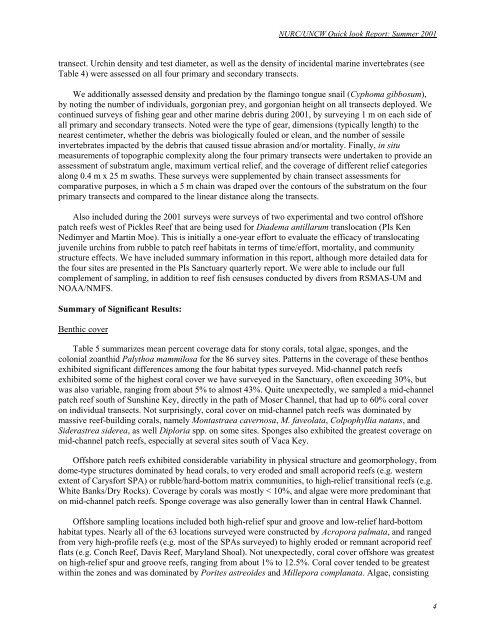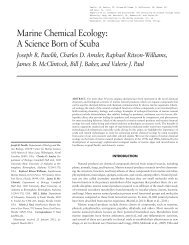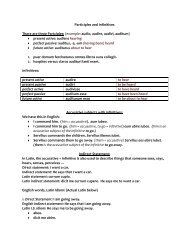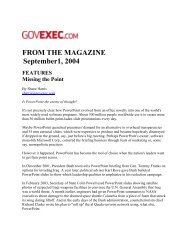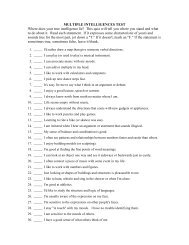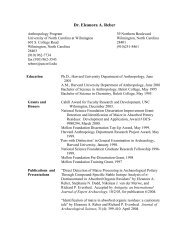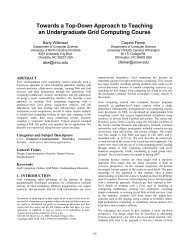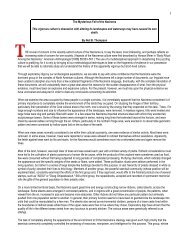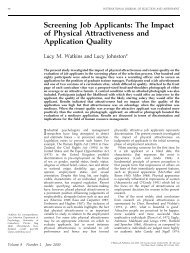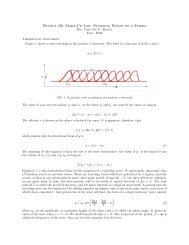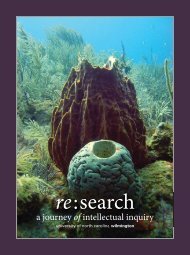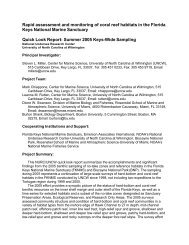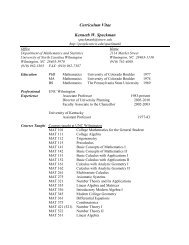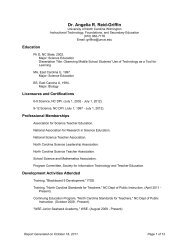Quicklook Report 2001 - People Server at UNCW
Quicklook Report 2001 - People Server at UNCW
Quicklook Report 2001 - People Server at UNCW
Create successful ePaper yourself
Turn your PDF publications into a flip-book with our unique Google optimized e-Paper software.
NURC/<strong>UNCW</strong> Quick look <strong>Report</strong>: Summer <strong>2001</strong><br />
transect. Urchin density and test diameter, as well as the density of incidental marine invertebr<strong>at</strong>es (see<br />
Table 4) were assessed on all four primary and secondary transects.<br />
We additionally assessed density and pred<strong>at</strong>ion by the flamingo tongue snail (Cyphoma gibbosum),<br />
by noting the number of individuals, gorgonian prey, and gorgonian height on all transects deployed. We<br />
continued surveys of fishing gear and other marine debris during <strong>2001</strong>, by surveying 1 m on each side of<br />
all primary and secondary transects. Noted were the type of gear, dimensions (typically length) to the<br />
nearest centimeter, whether the debris was biologically fouled or clean, and the number of sessile<br />
invertebr<strong>at</strong>es impacted by the debris th<strong>at</strong> caused tissue abrasion and/or mortality. Finally, in situ<br />
measurements of topographic complexity along the four primary transects were undertaken to provide an<br />
assessment of substr<strong>at</strong>um angle, maximum vertical relief, and the coverage of different relief c<strong>at</strong>egories<br />
along 0.4 m x 25 m sw<strong>at</strong>hs. These surveys were supplemented by chain transect assessments for<br />
compar<strong>at</strong>ive purposes, in which a 5 m chain was draped over the contours of the substr<strong>at</strong>um on the four<br />
primary transects and compared to the linear distance along the transects.<br />
Also included during the <strong>2001</strong> surveys were surveys of two experimental and two control offshore<br />
p<strong>at</strong>ch reefs west of Pickles Reef th<strong>at</strong> are being used for Diadema antillarum transloc<strong>at</strong>ion (PIs Ken<br />
Nedimyer and Martin Moe). This is initially a one-year effort to evalu<strong>at</strong>e the efficacy of transloc<strong>at</strong>ing<br />
juvenile urchins from rubble to p<strong>at</strong>ch reef habit<strong>at</strong>s in terms of time/effort, mortality, and community<br />
structure effects. We have included summary inform<strong>at</strong>ion in this report, although more detailed d<strong>at</strong>a for<br />
the four sites are presented in the PIs Sanctuary quarterly report. We were able to include our full<br />
complement of sampling, in addition to reef fish censuses conducted by divers from RSMAS-UM and<br />
NOAA/NMFS.<br />
Summary of Significant Results:<br />
Benthic cover<br />
Table 5 summarizes mean percent coverage d<strong>at</strong>a for stony corals, total algae, sponges, and the<br />
colonial zoanthid Palythoa mammilosa for the 86 survey sites. P<strong>at</strong>terns in the coverage of these benthos<br />
exhibited significant differences among the four habit<strong>at</strong> types surveyed. Mid-channel p<strong>at</strong>ch reefs<br />
exhibited some of the highest coral cover we have surveyed in the Sanctuary, often exceeding 30%, but<br />
was also variable, ranging from about 5% to almost 43%. Quite unexpectedly, we sampled a mid-channel<br />
p<strong>at</strong>ch reef south of Sunshine Key, directly in the p<strong>at</strong>h of Moser Channel, th<strong>at</strong> had up to 60% coral cover<br />
on individual transects. Not surprisingly, coral cover on mid-channel p<strong>at</strong>ch reefs was domin<strong>at</strong>ed by<br />
massive reef-building corals, namely Montastraea cavernosa, M. faveol<strong>at</strong>a, Colpophyllia n<strong>at</strong>ans, and<br />
Siderastrea siderea, as well Diploria spp. on some sites. Sponges also exhibited the gre<strong>at</strong>est coverage on<br />
mid-channel p<strong>at</strong>ch reefs, especially <strong>at</strong> several sites south of Vaca Key.<br />
Offshore p<strong>at</strong>ch reefs exhibited considerable variability in physical structure and geomorphology, from<br />
dome-type structures domin<strong>at</strong>ed by head corals, to very eroded and small acroporid reefs (e.g. western<br />
extent of Carysfort SPA) or rubble/hard-bottom m<strong>at</strong>rix communities, to high-relief transitional reefs (e.g.<br />
White Banks/Dry Rocks). Coverage by corals was mostly < 10%, and algae were more predominant th<strong>at</strong><br />
on mid-channel p<strong>at</strong>ch reefs. Sponge coverage was also generally lower than in central Hawk Channel.<br />
Offshore sampling loc<strong>at</strong>ions included both high-relief spur and groove and low-relief hard-bottom<br />
habit<strong>at</strong> types. Nearly all of the 63 loc<strong>at</strong>ions surveyed were constructed by Acropora palm<strong>at</strong>a, and ranged<br />
from very high-profile reefs (e.g. most of the SPAs surveyed) to highly eroded or remnant acroporid reef<br />
fl<strong>at</strong>s (e.g. Conch Reef, Davis Reef, Maryland Shoal). Not unexpectedly, coral cover offshore was gre<strong>at</strong>est<br />
on high-relief spur and groove reefs, ranging from about 1% to 12.5%. Coral cover tended to be gre<strong>at</strong>est<br />
within the zones and was domin<strong>at</strong>ed by Porites astreoides and Millepora complan<strong>at</strong>a. Algae, consisting<br />
4


